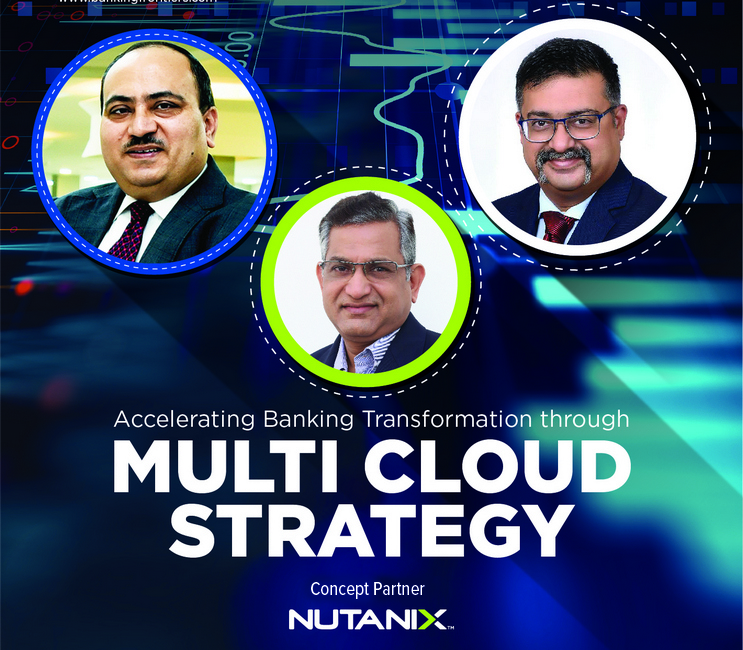
Technology experts spell out numerous technology opportunities to transform the BFSI sector, and zero in on the crucial.
Banking and financial services are being disrupted with new business models and rapidly changing customer expectations driving the behavior. A McKinsey research shows that shows that the top business transformations of the past decade has correlated maximum impact of digital transformation on 3 aspects (i) repositioning of the core business (ii) creation of new offerings and business models and (iii) robust financials.
Biswabrata Chakravorty, CIO at IndusInd Bank, explains the underpinning strategy for developing disruptive business models: “It start with reimagining customer experiences – companies which have reimagined their core mission and offerings around this principle have been top business transformers. Examples like PinAn, DBS and Netflix have all created digital experiences which have shaped customer behavior.”
Best in Class CX

Biswabrata Chakravorty, CIO, IndusInd Bank
While traditionally CX is confused with measures of customer service, best in class CX requires a rethink of journeys leading to impacts on UX using technologies like AI. AI based decision-making is now making it possible to create higher order customer experiences such as autonomous cars. For banks – this rethinking has led to experiences ‘beyond banking’ which is delivering a marketplace for customers across the value spectrum of banking, wealth management, utility, social experiences, from a single app.
The most critical component of delivering a set of digital experiences is the ability to harness data to discover, know and engage a customer meaningfully across a multi experience platform, affirms Biswabrata.
Naturally, technology enabled customer journeys are not friction free. Shiv Kumar Bhasin, COO & CTO at NSE, suggests a methodology: “We must look at all friction points in each customer journey from a detailed perspective. A matrix needs to be drawn for each customer journey with respect to various channels and alternate business options given to customer. This study will provide comprehensive list of friction points. We must draw customer empathy maps covering these friction points, which will provide the really transformed CX.”
Self-intuitiveness of the product/platform feature/service, ease of use, minimum clicks (say 2 clicks), no data loss in case of any network glitch, self-population of personalized data either from the government databases or from the artefacts scanned/photgraphed by the device itself, are the key CX parameters, believes Shiv Kumar.
Biswabrata adds a new dimension on CX – gesture enabled API driven journeys can create a meaningful value for customers on voice, video over and above chat-based interactions.
Since technology keeps changing rapidly and every change is expensive, the question that banks must ask is this: what front-end and back-end technologies are long-term allies of banks in this journey? Shiv Kumar responds: “Kubernetes based out of Pivotel Cloud Foundry is the best technology to build microservices oriented architecture-based services for front and back-office applications of BFSI industry. For experience there are various libraries like Magento open source or licensed enterprise edition, Hybris from Adobe, etc.”
ARCHITECTURE
Newer applications are developed on cloud native architecture based out of docker/Kubernetes/etc containers. However, 90-95% application are still based on traditional 3-2 tier based architecture applications, exclaims Shiv Kumar, adding: “We are planning to grow with multi-cloud/hybrid cloud approach.”
In India, more financial services companies are looking at newer systems of engagement to acquire more customers. “We are currently seeing a lot of SaaS applications which are being used by banks and other organizations to reach segments of society which they would not have ever reached before,” says Anantharaman Balakrishnan (Bala), VP & MD at Nutanix India
Biswabrata gives the banking perspective: “Digital architecture is built on the foundations of (i) open or API driven banking which can easily connect fintech and partners with a banking platform, making it seamless for customers (ii) a big data platform and advanced analytics and decision sciences to be able to make meaningful connections in the data (iii) a multi experience delivery for customers which can offer hyper-personalization and almost bring banking services to the power of 1 through the delivery of solutions, experiences and service.”
In today’s scenario, necessarily the enterprise bank has to collaborate with partners and fintech providers – and this creates a distributed computing environment across multiple clouds. Various industries have already adopted a hybrid cloud by distributing core workloads on premise and digital workloads like the edge on the cloud, and banks are pursuing the same strategy as well.
HYBRID CLOUD

Bala, VP & MD, Nutanix India
Customer interaction is a vital element in BFSI – and their increased sophistication and requirements means that FSIs require a simple and speedy solution to respond to their increasingly demanding requirements. Start-ups and fintech have responded with a preference for cloud-based solutions while banks have preferred on-premise solutions. Is hybrid cloud then the next step for banks in their journey towards CX excellence?
Biswabrata believes that as long as the experience of a public cloud can be delivered securely on premise, there will be a focus on automating and improving the efficiencies on private clouds whether on premise or a private tenant on the public cloud. “Use cases will be driven by benefits from dev/ops, privacy and data security. There is a trend to explore container platforms to leverage hyper scale (both on public cloud and on private clouds), which is leading to re-architecture of monolithic architectures of the past. OEM collaboration is bringing these advantages more rapidly on public cloud,” he explains.
Various independent research commissioned by Nutanix indicates that the overall BFSI vertical outpaces all other industries in hybrid cloud deployments. One key reason is that HCI and hybrid cloud enables faster application roll-out and is ideal for reducing the time to customer as it provides the flexibility needed to deploy the right cloud environment on request, avers Anantharaman. Increased simplicity, flexibility and governance also make HCI ideal for the sector.
Key Issues
Shiv Kumar emphasizes the regulatory and cost perspectives, which he considers as key issues: “Hybrid cloud architecture would be most suitable for regulated environments, where applications with less sensitive data or cloud solution with better security solutions in place can host application services. Hosting SaaS services on cloud and core applications on premise on private cloud is the strategic approach to go ahead. Unless the cloud service providers address the cost concerns of the cloud infrastructure services, public clouds would be used only by low volume, start-up organizations.”
“In an increasingly regulated environment, maintaining data sovereignty remains a big concern. As data volume increases, being able to see all of your data and then isolate, or ringfence, proprietary or legally mandated information, will require hybrid cloud systems,” adds Anantharaman.
Rise in remote workers and WFH arising out of covid and lockdown, has necessitated the need for tightened regulations especially with respect to data – its locality and access. In this context Anantharaman points out the regulatory benefit of a multi-cloud strategy: “Multi-colud enables financial institutions to uphold data sovereignty (Laws of the Land). By ringfencing locally required, sensitive and personal data on private cloud, while permitting global access to customer-facing apps and digital workloads, hybrid cloud can fulfil both requirements while enhancing the organization’s ability to be efficient and profitable.”
A growing number of financial services organizations have discovered that an HCI cloud offers the agility of public cloud without sacrificing control over critical resources. But this is a move that cannot happen overnight and needs to be navigated carefully, requiring meticulous and mature consideration to decide which applications and services will run in the cloud. Success hinges on creating the right set of cloud environments that can power next-generation applications and better satisfy user expectations – while sustaining the traditional applications that business has relied on for years.
As long as the experience of a public cloud can be delivered securely on premise, there will be a focus on automating and improving the efficiencies on private clouds whether on premise or a private tenant on the public cloud. Use cases will be driven by benefits from dev/ops, privacy and data security. “There is a trend to explore container platforms to leverage hyper scale (both on public cloud and on private clouds), which is leading to re-architecture of monolithic architectures of the past. OEM collaboration is bringing these advantages more rapidly on public cloud,” add Biswabrata.
“Hybrid cloud is no longer a trend or niche technology, so we are seeing the mainstream and start up FSIs rush to adopt it. For traditional FSIs, hybrid cloud provides an immediate path to a more simplified and customer-responsive organization. As they modernize and navigate the adoption to cloud – they are able to bypass or short-cut the complex and cluttered traditional hardware-based IT infrastructure, without significant upheaval, disruption and cost,” avers Anantharaman.
Management Concerns

Shiv Kumar Bhasin, COO & CTO, NSE
Most CXOs agree that the priority of meeting digital business demands requires a hybrid cloud strategy. There is an element of risk in any environment and the hybrid cloud is no different. The strategies adopted by companies depends on their risk appetite and the business model. Biswabrata points to the strong emergence of InsurTech which is disrupting the insurance business, with many new age insurers adopting cloud for their entire stack from day 1.
Shiv Kumar enumerates the three key management concerns – Cost, Data Security and Regulatory Compliance for data residency/sovereignty, ie having all 3 data centre sites of cloud (Production Near DR, and DR) within the country, and moving the data back to on-premise or to alternate cloud.
As per regulations, at no-time should the data leave the data center in the country, not even for maintenance of cloud infrastructure from remote. Once large data is on cloud, how to get it quickly on-premise due to sudden changes in regulatory environment is big concern. Unless fastest data transfer mechanism to on-premise at no or minimum cost are provided, this is going to be a bottleneck, avers Shiv Kumar.
Anantharaman emphasizes that Nutanix brings a broad range of capabilities including ‘security-first design’ and ‘defense in depth’ to fit the stringent requirements typical of any financial services institution. Security in the enterprise must begin with a robust infrastructure foundation. This is where Nutanix not only provides operational and financial value, but also aids in improving security posture and preventing data breaches by ensuring these critical areas are a focal point. Its security offerings include event-driven security monitoring in real time, policy-based automation, and one-click remediation for security controls and configuration.
Risk management for the hybrid cloud should be visited holistically from a cyber security point of view, says Biswabrata. The alignment between CISO and CIO must happen to ensure that the risk to the enterprise is managed in a consistent and process driven manner while leveraging the obvious benefits of a hybrid cloud.
Cost is another management concern, opines Shiv Kumar. “Cloud cost must be optimized compared to on-premise deployments. Lot of organizations are capex centric. High opex cost of cloud companies will be roadblock to concur the infrastructure services approach. Data security and data residency with respect to land of law, must need to be adhered with best possible solutions as the feature of the services, rather than each client negotiating this as part of contract negotiations financially and legally.”
Winner banks and financial institutions are likely to be the ones that navigate these concerns quickly, smartly and wisely as they increasingly adopt hybrid cloud in their march towards CX excellence.
——————–







